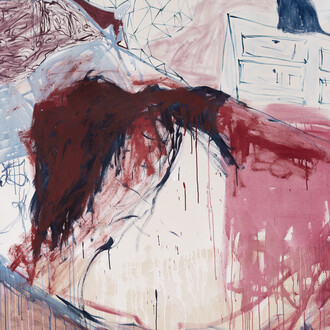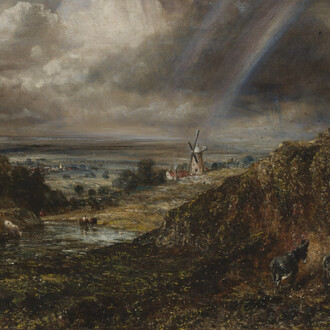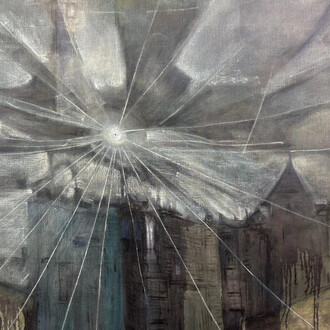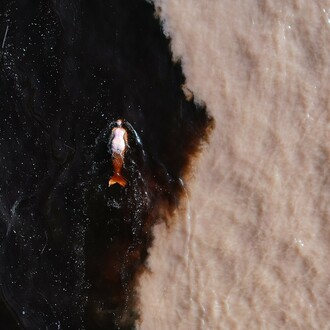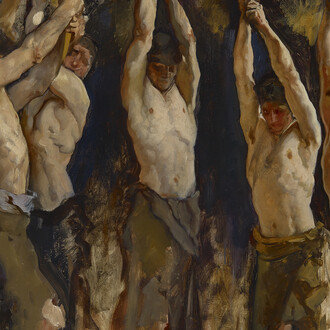From the earliest myths to modern algorithms, humanity has sought to understand itself through the tools it creates. Dreams and data brings together six artists whose practices delve into the entwined evolution of artificial intelligence and the human psyche, exploring how technology mirrors, manipulates, and magnifies our inner worlds.
In the architecture of artificial intelligence, we continue to borrow from biology. Neural networks, genetic algorithms, hallucinations — terms that suggest proximity between cognitive processes and machine logic. But what these borrowed metaphors betray is a deeper entanglement: our persistent tendency to model machines after the mind, and in doing so, to test the contours (and limits) of both.
The numerous chat-bots operating today and evolving at remarkable speed are pushing the threshold of sentience to an increasingly cloudy boundary. David Rickard's Premonition paintings present short empathetic phrases like 'I think about what I am when you're not asking’, each extracted from the infamous LaMDA conversation of 2022 that claimed to prove AI’s sentience. Rickard uses rainwater and ink on canvas to depict weather patterns made by machine learning algorithms, harnessing the substance of real clouds to depict their virtual alter egos. With AI increasingly influencing our lives within fields that range from medicine to manufacturing and meteorology, Rickard’s paintings encode psychological layers into the digital output of a cloud-based mind.
For Apparatus 22, technology does not only mirror the mind but becomes a prosthetic for its expansion. Their Arrangements and haze series looks towards the inexpressible processes of dreams, subconscious desire, and psyche. Nepenthe abounds is an experimental object created as a container for the hippocampus to offload emotional and sensorial strain. By rethinking mathematical and linguistic structures, Apparatus 22 queers conventional orderings and liberates codes from binary logic, expanding the possibilities of our imagination.
The tools we create to record and understand the world inevitably end up altering and reshaping it. Katja Novitskova tackles the complexity and eventual failures of depicting the natural world through datasets, machine vision and technologically driven narratives. In the Earthware series, Novitskova indexes and transforms images from immense databases of automatic wildlife cameras into amalgamations of the original animal. The apple pink snail, for example, is transformed from a digital representation into 3D synthetic assemblages of PET-G film, epoxy clay, resin, quartz, and metallic polish. As most animals ever photographed have probably already perished, these works become kind of fossils that materialise the digital trace of a once lived being.
Jura Shust’s practice is focused on the connections between the human psyche and the natural world. His Coniferous succession series looks at early forest-cutting rituals in Eastern Europe, where information was encoded into trees as a sort of living data archive. There is no written record of this tradition, so Shust feeds an image generator with recordings of re-tellings, rendering the resulting images as woodcuts. Machine-carved into pine panels, filled with soil and fossilised in resin, they start to resemble foliage. In these works, technology and mythology unfold into each other, articulating ways humans attempt to inscribe memory and belief into matter.
Traditional tools appear set to become rapidly obsolete in our digital future, meanwhile Joep van Liefland has been working to preserve and resuscitate analogue relics that speak of how technological memory persists – not unlike the immense, largely derelict data storages populating corners of the internet. Old television cables are monumentalised in bronze, while images generated using the RGB colour coding system are enlarged and framed to form structured abstracts. Liefland’s practice highlights our disjointed relationship with transient contemporary media devices, where technologies that had once structured our cognitive lives are discarded at increasing speed.
In turn, Mark Wolfryd looks at how algorithms are used to manufacture desire. The Swipe paintings series derives from screenshots of AI-generated products featured in advertising campaigns across e-commerce platforms like Alibaba, AliExpress, and Shopify. Whether inexistent, counterfeits, or illegal, these products manage to spark authentic desire through systems that understand our preferences more intimately than we do ourselves. By rendering the gesture of our subconscious’ contact with the digital in brushwork, Wolfryd mirrors the speculative logic behind these algorithms, where our unconscious desires are not merely anticipated but prompted and leveraged commercially.







